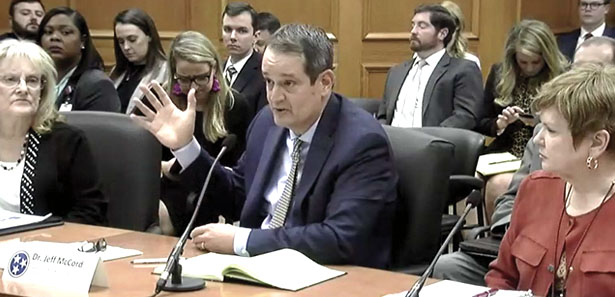Rich Panek, CEO and Dr. David Moulton, medical director of quality
State of Franklin Healthcare Associates (SoFHA), like most healthcare provider organizations, radically altered its business model in 2020 to meet the needs of patients during the Coronavirus pandemic. As the pandemic care model shifted from testing and masking to vaccination promotion in early spring 2021, the Business Journal spoke with CEO Rich Panek and Medical Director of Quality Dr. David Moulton regarding SoFHA’s performance over the previous 12 months and its priorities amid the uncertainties of the year ahead.
The Business Journal: Before the pandemic hit where were you in terms of number of active patients and patient encounters per year and how did those numbers change for you in 2020 as a pandemic hit?

Rich Panek: Before the pandemic hit we were running about 350,000 to 400,000 encounters per year. What we saw when the pandemic hit in March was a precipitous drop through April and most of May. And what I mean by dropped, our daily volume dropped probably 60 percent at one time in March. It started easing back up a little bit in April and May. Now, what helped us in that transition is we very quickly – literally in two weeks – rolled out telehealth. We peaked at about 1,400 telehealth visits a week, which is pretty strong. So, by April 2020 we were doing roughly 1,000 to 1,400 telehealth visits a week. That has rolled up and down lately. It’s down to about 500 a week right now.
But the volume aggregately – 2020 compared to 2019 – even with telehealth we ended up in general being off about 15 percent of our encounter volume compared to the previous year, between 35,000 and 50,000 encounters off.
We actually increased gross revenue by 21 percent from $126 million to $152 million from 2019 to 2020, but that’s purely because we grew the clinics. So, we would have to back out the clinic growth and get to the core book of business, which is what I was speaking of.
For unique patient encounters, we went from 390,000 in 2019 to 432,000 in 2020. We increased that figure 11 percent and we had a 21 percent increase in charges due to clinic growth, but we actually had some fewer patients on the core book of business, so we dropped from 118,000 patients to a 106,000 or 10 percent. If you just look at the static book of business, we ended up off about 15 percent in 2020 compared to 2019, when you set the new business aside.
BJ: State of Franklin took part in the Pfizer vaccine testing process and recently in our sister publication the Johnson City News & Neighbor, another doctor who was involved in that process said he is frustrated today that the careful work that he witnessed with his own eyes is trusted less in many quarters than an anonymous social media post. So, at this point in time, early spring of 2021, what I’m hearing out there is that we’re at a crossroads right now both nationally and as a region. We’ve got roughly a third of the population, both national and as a region, vaccinated. But, the health departments are saying that we’re seeing a slowing of the vaccination rate even as eligibility becomes total. So, what is State of Franklin doing to maximize the vaccination rate among your own patients, and are you taking part in any other efforts to encourage vaccination in the general population?

Dr. David Moulton: So, if you go to the CDC tracker, they will give you a breakdown of who’s been vaccinated 65 and older and who’s been vaccinated 18 to 65. If you look at the population above 65, I think 40 million have been vaccinated, so around 73 percent have had at least one shot. But, if you look into the 18 to 64 category, there’s been around 100 million that have had one shot. That’s only 37 percent of the population. So, you do the math and then you have 200 million out there that have not had a shot. So, it’s important to segment them and understand what is your strategy for the greater-than-65-year-olds who mostly have been compliant to vaccinations throughout their lives? They’ve seen polio. They’ve seen some of the measles, pneumonias, and death. They have probably seen smallpox, you know, so what they want is a face-to-face with their doctor so they can ask, ‘did you take it and why?’ That’s mostly what I’m getting in the older than 65 group. They want to know whether I trust it and did I take it. Then I would say 90-plus percent of them are signing right up to do it.
If you look at the population between 18 and 64, it seems to be it breaks down into a few things. One is, ‘I don’t trust the government.’ One is, ‘it’s brand new and I usually wait on new things.’ Another is fetal cells. And then another is, ‘I’m hearing a lot about side effects.’
So, we are trying to approach that with education. We have developed information sheets about how the mRNA vaccine works and we hand those out. Early on, we developed a sheet that was focused on the fact that there’s no preservative in this vaccine because a lot of the anti-vaccine crowd is against thimerosal which is a preservative. That’s seemed to be helpful.
So just patient by patient, one by one, you go through it. If the patients come in and they say they don’t trust the government, well, it’s pretty clear that the government didn’t make this vaccine. It was from private companies and one of the reasons why the trials went so fast is we had a tremendous number of volunteers. Most trials, to get the cohort that they need to test the vaccine takes months, for this one people signed up within a week. They had all the people they needed within a week. So, there’s different reasons why this vaccine came out quicker. We try to explain that, and I have had success with that.
The people who want to wait – yesterday I had a man who wanted to wait. But by age group and by disease state, I explained to him, ‘you are a high-risk individual and by waiting you’re actually putting yourself at greater risk. Because of your age and condition, you’re not in the less than one percent risk category, you’re more in the greater than 10 percent risk.’ I think a lot of people do not realize that their risk is based on their pre-existing disease states (such as diabetes or leukemia) and other factors.
The fetal cells, I don’t know what to say about that. And then the allergic reaction, I think, has been played up a lot. Side effects have been played up. So, we talk about that how your body is going to have immunological response in the first 24 hours and actually that is okay because it tells you that you’re having a response.
So, I think you have to pick apart each individual person’s reason why they are hesitant.
One other point: This age group can turn out to be the super-spreaders. And so, one of the focuses is on. ‘who in your family are you around? You know, do you have elders who’re in your church family?’
I like what everybody is doing. I like what the health department’s doing. I like what Ballad is doing. I like what we’re doing. Everybody’s trying to do more outreach and engage. It takes all of us working together to try and get the message out that this is a brilliant vaccine with very low side effects, like one in 200,000 has an anaphylaxis. So, that’s sort of a long response because it’s a simple question but it’s also very complex.
BJ: The uncertainty about whether we’ll be able to achieve herd immunity or have to start all over again in a few months addressing variants that the current vaccines weren’t made to address makes everybody’s crystal balls hazy at best. But, that having been said, you’ve still got COPD out there. You’ve got cancer to treat. There’s still diabetes. You’ve got everything else that needs to be treated and frankly, this region had a higher risk of all those things than average to start with. In short, you still have to run a business and you still have to run a practice. So, even with a hazy crystal ball, what can you tell us with any certainty about SoFHA’s priorities moving forward?
RP: A big initiative for us for this year is the integration of Mountain Region Family Medicine into our group. They became part of SoFHA January first of this year. They have five practice locations, two in southwest Virginia. They have 20 or 21 providers in their group right now. They’re a very good group. Culturally, they’re very similar to us. They’re a high-quality, very efficient, very productive group.
However, they’re on different systems, largely, than we’re on. They have different business systems and different electronic health records (EHR), so we’ve just moved them to a new business system, Allscripts Professional. They’re still on their previous EHR, so there are data transfer issues. There are business systems issues that need to be implemented. We’re a little bit more sophisticated perhaps than them in terms of some of our business practices. and certainly Dr. Moulton can speak to some of the crosswalk of the clinical protocols and clinical practices. So, that’s going to take a major effort of us this year.
Another very exciting project we’re working on is finishing off our state certifications of our SoFHA Imaging services. Half of the center’s been certified by the state. We have the license from the state of Tennessee and right now the other half is the breast center. The women’s center is being certified as well. Once that state certification is achieved, simultaneously, we’re submitting information to American College of Radiology to get all the machines – MR and CT – certified as well, for breast work primarily MR, and then we’ll be submitting that file to receive certification as a Breast Imaging Center of Excellence. To my knowledge, we’ll be the only one who has that in in the Tri-Cities. So, the hope for the women is if they come in with a lump, to have identification of the lump all the way, potentially, through biopsy and diagnosis in one day.
The third piece of it is working closer with Ballad. We are engaged with Ballad in what’s called the Hospital Quality Efficiency Program (HQEP) primarily in Washington County (Tennessee) right now at Johnson City Medical Center and Franklin Woods. There are three legs to that stool. One is facility-based quality and cost. The second is helping them be compliant with COPA metrics. The third is helping them improve the care and reduce the cost of their care for their employees, their beneficiaries, our patients.
Dr. Moulton serves on an operating committee in the board of that effort. We have a joint venture with Ballad named Quality Improvement Partners. We’re co-owners of that company and so we are really seeing some good early results from that relationship and potentially hope to grow that into Sullivan County. So, that’s a big initiative for us this year as well.
The last initiative for us is working with the payers. We’re taking additional risk with the payers. With two of our Medicare Advantage plans we’re at 100 percent upside/downside risk on the gainsharing with them right now and we’re trying to move that way with a third. That’s going to demand implementation of sophisticated care systems, care monitoring systems, and care delivery systems. So, we’re leaning on Dr. Moulton to make sure the analytics are timely and that we’re not getting behind either compliance curves related to quality metrics or losing our way in terms of providing that care efficiently. We work very closely on those agreements together. That’s where a big part of this whole quality improvement team comes in, making sure we’re doing well in meeting the requirements of those agreements.
DM: And I would add that what is generated by this collaboration and trust between the business side and the clinical side is the ability to practice at a very high level for the patients without being told you have to see so many patients per day or you have to do more of this or that. Just the freedom, the independence to conduct your practice in an evidence-based way has been a luxury. I think the culture that has been promoted has been one of excellence across the board.




